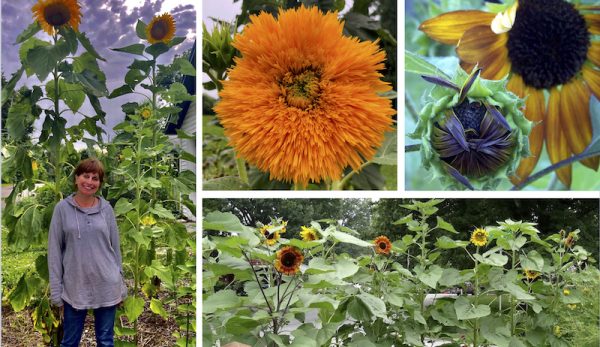
It seems as if there are as many reasons to grow sunflowers as there are different types to try. Sunflowers can produce loads of nutritious pollen and seeds to support area insects and wildlife. The impossibly tall kinds can serve as living trellises for vining beans, morning glories and more. And some of the smaller, branching types make eye-popping additions to cut-flower bouquets.
No matter why you might want to grow your own sunflowers, you’ll need a garden spot that gets plenty of sun. If you have the space, you could easily fill a half-acre field with the nodding, cheerful flowers. But, thanks to some of the dwarf varieties now available, you could grow just a couple of the beauties on a small-but-sunny balcony instead.
Novelty Varieties
Recently, I’ve been experimenting with rare and novelty varieties to see just how tall my sunflowers can grow. Got room to spread out? (And maybe some kiddos or neighbors you’d like to delight?)
In that case, you might want to try some of these.
Mammoth Grey Stripe and Mongolian Giant are available in most garden centers and big box stores. Both can produce monster-sized seeds on flower heads that are more than a foot wide. While Mammoth Grey Stripe typically reaches 10 to 12 feet tall, I’ve had Mongolian Giants grow even taller. Although each of these will develop extra-thick trunks to support their heavy heads, you may need to offer additional support.
I’ve also had great luck with two other extra-tall varieties—Skyscraper and Eiffel Tower. I ordered both of these through the Seed Savers Exchange. There, participating gardeners share their open-pollinated and heirloom seeds via this online community.
Although Exchange participation was once reserved for Seed Savers Exchange members, it’s now open to the public.
At minimum, Skyscraper can reach 12 feet. But in rich soil—and with a little support as needed—it can zoom beyond that. Skyscraper produces multiple branches of 12- to 14-inch-wide flowers. As for Eiffel Tower, it’s a rarer variety hailing from the United Kingdom. In the right conditions, it can grow up to 18 feet tall.
If that’s a little too tall for you, you might want to try the more diminutive Tall Orange Sunflower. Mine were just over 5 feet high with fluffy, doubled blooms.
Read more: Pretty up your plate with some garden-grown edible flowers!
Helping Birds & Bees
I offer area birds black oil sunflower seed well into spring and sometimes find volunteer sunflowers growing beneath the feeder. I’ve successfully transplanted many of these, and the birds flock to the resulting seed heads in mid- to late summer.
If you hope to attract butterflies, bees and other beneficial insects, you’ll want to plant sunflowers which offer plenty of pollen. (Be aware that some hybrid varieties do not produce pollen. There’s a whole class of “pollenless” sunflowers, in fact.)
The Lemon Queen Sunflower is one reliable nectar-and-pollen-producer that’s attractive to insects and simple to grow. (It’s also the star of the Great Sunflower Project, a Citizen Science bee-counting initiative that’s been around since 2008.) Lemon Queen will grow to be between 5 and seven 7 tall and produces multiple branches of pale yellow flowers.
I also really like The Birds & Bees mix from Renee’s Garden. The sunflowers range from 6 to 8 feet tall and produce nutritious, oil-rich seeds. Goldfinches and bumblebees, in particular, were some of my most frequent visitors.
Better Bouquets
With flowers of deep burgundy-chocolate and bronze, both the Velvet Queen and Evening Sun sunflower varieties add drama to cut-flower arrangements. Velvet Queen produces 4-inch-wide blooms and can grow from 5 to 7 feet tall. Evening Sun can grow up to 8 feet tall.
Its flowers are also slightly larger.
The Goldy Honey Bear Sunflower is also worth a look. Like Tall Orange, it produces fuzzy, pettable blooms; however, Goldy Honey Bear is shorter. A pollen-less variety, Goldy Honey Bear produces 5- to 10-inch, yellow blooms on 4-foot-tall stalks.
What’s more, the stems are long enough for use in bouquets.
Read more: Grow these old-fashioned flowers in your garden for something ‘new.’
Small but Mighty
If you don’t have much space, you can opt for dwarf varieties like Dwarf Sunspot. It produces 10-inch, yellow flowers but only grows 2 to 3 feet high. And the Gold Ring Sunflower is even smaller, reaching just 20 inches tall with 2- to 4-inch blooms.
Get Growing
Whichever sunflowers you try, most can tolerate even so-so soil. But they’ll really thrive in nutrient-rich, well-draining conditions. And, although sunflowers can be transplanted, I’ve found that mine grow best when I direct-sow them outdoors. Provided I’ve included adequate protection for them, that is.
To keep rabbits, deer and other nibblers out, I surround my seedlings with plastic cloches and temporary fencing. Once my plants are well-established, I simply remove the extra protection.




